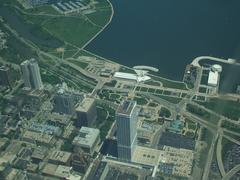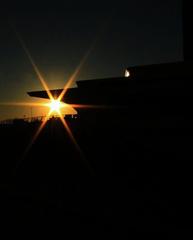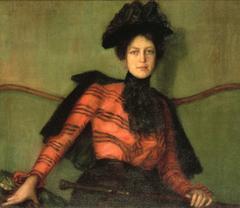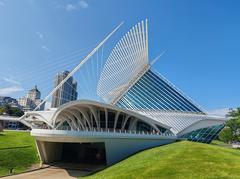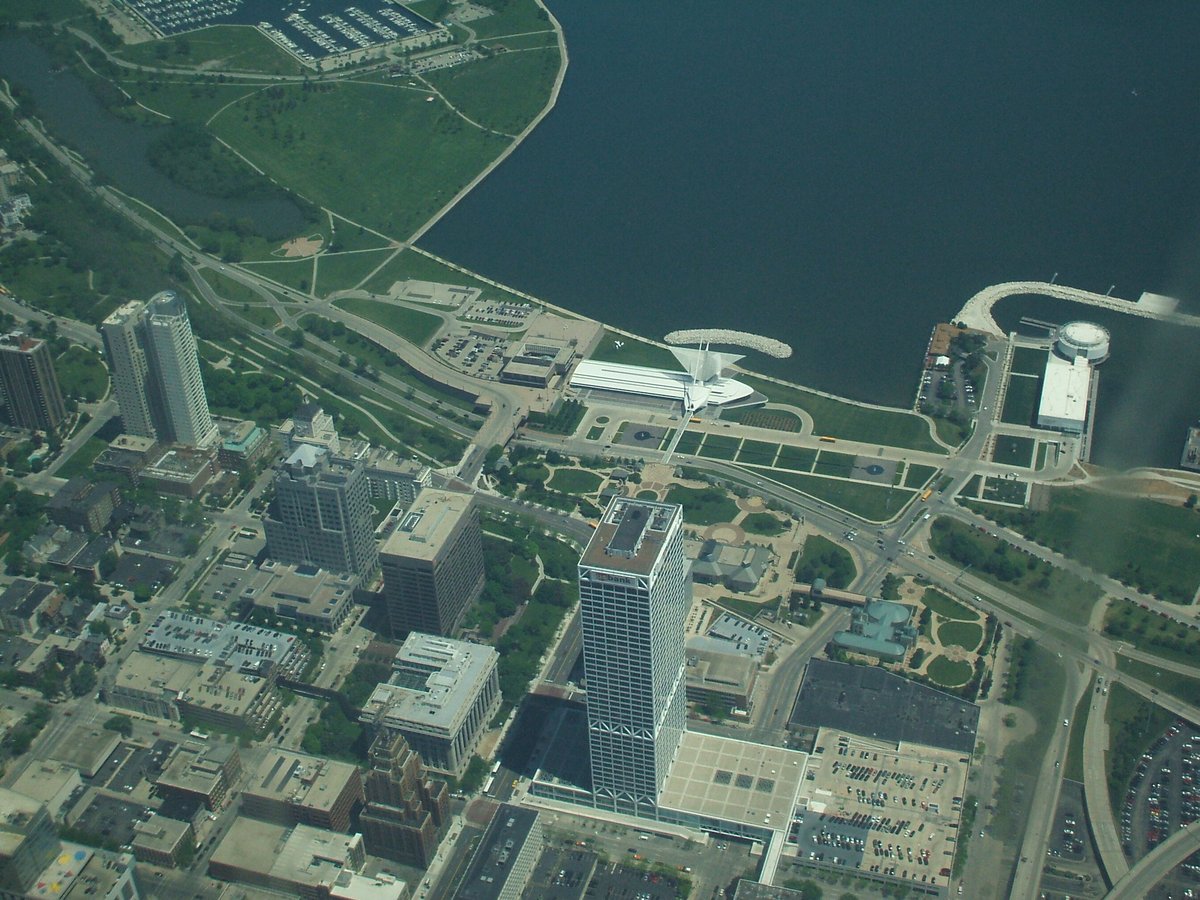
Milwaukee Art Museum Visiting Hours, Tickets, and Guide to Milwaukee Historical Sites
Date: 14/06/2025
Introduction: The Milwaukee Art Museum’s Legacy and Significance
Located on the scenic shores of Lake Michigan, the Milwaukee Art Museum (MAM) has evolved into one of the Midwest’s foremost destinations for art, architecture, and cultural exploration. Founded in 1888, the museum’s journey from its early roots in the Layton Art Gallery to its current status as a landmark institution reflects Milwaukee’s enduring commitment to cultural enrichment and community engagement. Today, the museum is celebrated for its vast collection of more than 30,000 works, its engaging educational programs, and its iconic architecture, notably the Quadracci Pavilion designed by Santiago Calatrava. The Pavilion’s kinetic Burke Brise Soleil “wings” have become a symbol of the city, drawing visitors from around the world.
Whether you are an art lover, history enthusiast, or traveler seeking to experience Milwaukee’s vibrant cultural scene, this guide provides detailed, practical information to help you plan an unforgettable visit. Discover the museum’s historical milestones, current exhibitions, visiting hours, ticketing options, accessibility features, family-friendly amenities, and tips for exploring nearby historical sites and attractions.
For up-to-date information on hours, tickets, and events, visit the official Milwaukee Art Museum website and consider using digital resources like the Audiala app for audio tours and travel tips. Embark on a journey through art, architecture, and Milwaukee’s rich heritage at this must-see destination. (Milwaukee Art Museum Visiting Guide, Calatrava News, Visit Milwaukee)
Historical Overview: The Museum’s Evolution
Foundations and Early Growth (1888–1950s)
The Milwaukee Art Museum’s origins trace back to the establishment of the Layton Art Gallery and the Milwaukee Art Association in 1888. Frederick Layton, an English immigrant and meatpacking magnate, founded the Layton Art Gallery to house European and American artworks, while the Milwaukee Art Association (later the Art Institute) focused on supporting local artists. Their proximity and collaboration set the stage for Milwaukee’s growth as a cultural hub.
Postwar Transformation and Merger (1957–1975)
Following WWII, the Layton Art Gallery and Milwaukee Art Institute merged in 1957, forming the Milwaukee Arts Center. This coincided with the opening of the Milwaukee County War Memorial Center, designed by Eero Saarinen, integrating memorial and cultural functions in an innovative modernist structure overlooking the lake.
Expansion: The Kahler Building and Institutional Growth (1975–1990s)
David Kahler’s 1975 addition expanded gallery space and reinforced the museum’s lakeside presence. In 1980, the institution became the Milwaukee Art Museum, further growing its collections—especially through notable donations of folk art and decorative arts. Partnerships, such as the one with the Chipstone Foundation, helped broaden the museum’s scope into American decorative arts.
The Quadracci Pavilion: A New Era (2001)
The opening of the Quadracci Pavilion in 2001 marked a transformative moment. Designed by Santiago Calatrava, the Pavilion introduced the spectacular Burke Brise Soleil “wings,” Windhover Hall’s soaring spaces, and a dramatic pedestrian bridge, elevating the museum’s architectural profile and visitor experience.
Modernization and Recent Renovations (2015–Present)
A major renovation in 2014–2015, led by HGA architects, modernized the original buildings and introduced the East End addition with expanded galleries and lake-facing windows, accommodating increased visitor numbers and contemporary exhibition needs.
Practical Visitor Information
Visiting Hours
- Tuesday–Sunday: 10:00 AM – 5:00 PM
- Thursday: Extended hours until 8:00 PM
- Monday: Closed
Check the official Milwaukee Art Museum website for holiday hours and special event schedules.
Tickets and Admission
- Adults: $19–$20
- Seniors (65+): $15–$17
- Students (with valid ID): $12–$14
- Children under 12: Free
- Members: Free
- Discounts: Available for military, groups, and during citywide promotions
Tickets can be purchased online in advance or at the entrance. Advance booking is recommended for special exhibitions or during peak seasons.
Accessibility
The Milwaukee Art Museum is fully accessible. Features include:
- Wheelchair-accessible entrances, elevators, and restrooms
- Assistive listening devices and tactile tours
- Family amenities: stroller access, nursing rooms, and family restrooms
- Service animals are welcome
Visit the museum’s accessibility page for details.
Getting There and Parking
- Address: 700 N Art Museum Dr, Milwaukee, WI 53202
- By Car: On-site paid parking garage; additional public lots and street parking nearby
- By Public Transit: Served by Milwaukee County Transit System (MCTS) bus routes (MCTS)
- By Bike/Foot: Accessible via lakefront trails and pedestrian pathways
- From Airport: Milwaukee Mitchell International Airport is about 10 miles away
Dining and Amenities
- Café Calatrava: Offers seasonal, locally inspired menus with lake views
- Museum Café: Light snacks and refreshments, with outdoor seating in summer
- Museum Shop: Art-inspired gifts, books, jewelry, and Milwaukee memorabilia
Exploring the Quadracci Pavilion: Architectural Highlights
The Quadracci Pavilion is the museum’s architectural centerpiece, designed by Santiago Calatrava and opened in 2001. Distinctive features include:
- Burke Brise Soleil: “Wings” span 217 feet and open/close daily (typically 10 AM and 3 PM). The spectacle is a visitor favorite (Calatrava Architecture).
- Windhover Hall: A glass-enclosed, light-filled atrium with panoramic lake views
- Pedestrian Bridge: Dramatic entrance connecting downtown Milwaukee to the museum
Pro Tip: Time your visit to catch the wings opening or closing—an iconic photo opportunity!
Collection Highlights
The Milwaukee Art Museum’s collection features:
- American Art: Extensive holdings from colonial to contemporary, highlighted by one of the world’s largest collections of Georgia O’Keeffe paintings
- European Art: Works by artists such as El Greco, Monet, and Zurbarán
- Haitian Art: Among the nation’s largest collections, celebrating vibrant traditions
- Decorative Arts & Folk Art: American and European furniture, ceramics, textiles, and local folk art
- Photography & Contemporary Art: Works by Cindy Sherman, Walker Evans, and Beth Lipman
Notable works include:
- Georgia O’Keeffe’s “White Flower No. 1”
- Francisco de Zurbarán’s “Saint Francis of Assisi in His Tomb”
Special Exhibitions and Events
- Upcoming (Spring 2025): The Brilliance of the Spanish World: El Greco, Velázquez, Zurbarán—A landmark exhibition featuring Spanish Renaissance and Baroque masterpieces
- Annual Events: Art in Bloom (spring), Lakefront Festival of Art (summer), family days, and gallery talks
- Guided Tours: Architecture and collection highlights available by advance booking or at the information desk
Check the museum’s event calendar for details and schedules.
Family-Friendly Features
- Kohl’s Art Generation Studio: Hands-on art activities for children
- Interactive Materials: “A is for Art” book and family guides
- Iconic LOVE Sculpture: Popular photo spot on the museum grounds
- Stroller Access and Family Restrooms: Throughout the facility
Nearby Attractions and Historical Sites
Enhance your visit by exploring:
- Discovery World: Science and technology center next door
- Milwaukee County War Memorial Center: Adjacent, honoring veterans
- Historic Third Ward: Nearby district with shops, restaurants, and galleries
- Lakefront Trail: Scenic walking and biking path along the lake
Visitor Tips
- Best Times: Weekdays and Thursday evenings for fewer crowds
- Plan 2+ Hours: To fully explore galleries and exhibitions
- Dress Comfortably: Wear walking shoes for the spacious museum layout
- Photography: Allowed for personal use (no flash/tripods); restrictions may apply in special exhibitions
- Budget: Estimate $50–$100 for two adults, including tickets, parking, and a meal
Frequently Asked Questions (FAQ)
Q: What are the Milwaukee Art Museum’s visiting hours?
A: Tuesday–Sunday, 10 AM–5 PM. Thursday open till 8 PM. Closed Mondays.
Q: How much are tickets?
A: $19–$20 for adults. Discounts for seniors, students, and children. Free for children under 12.
Q: Is the museum accessible?
A: Yes, with wheelchair access, elevators, and family amenities.
Q: Are guided tours available?
A: Yes, reserve in advance or at the information desk.
Q: Can I take photos?
A: Yes, in most galleries for personal use (no flash/tripods).
Q: Where do I park?
A: On-site paid garage and nearby street/public parking available.
Plan Your Visit
For the latest visiting hours, tickets, and event updates, visit the official Milwaukee Art Museum website. Enhance your experience with the Audiala app for audio tours and travel tips.
Stay connected on social media for exhibition news and special events. The Milwaukee Art Museum offers a memorable journey through art, architecture, and Milwaukee’s rich cultural landscape.
Sources
- Milwaukee Art Museum Visiting Guide: History, Architecture, Tickets & Tips, 2025, https://mam.org
- Visiting the Milwaukee Art Museum: Exploring the Iconic Quadracci Pavilion and Practical Visitor Information, 2025, https://calatrava.com/news/reader/calatrava-revisits-his-iconic-milwaukee-design-20-years-later.html
- Milwaukee Art Museum: Visiting Hours, Tickets, Collections, and Exhibitions Guide, 2025, https://mam.org
- Visitor Experience and Practical Tips at the Milwaukee Art Museum: Hours, Tickets, History, and More, 2025, https://www.visitmilwaukee.org/things-to-do/attractions/milwaukee-art-museum/
